heater HONDA PRELUDE 2000 Owner's Manual (in English)
[x] Cancel search | Manufacturer: HONDA, Model Year: 2000, Model line: PRELUDE, Model: HONDA PRELUDE 2000Pages: 293, PDF Size: 3.43 MB
Page 54 of 293
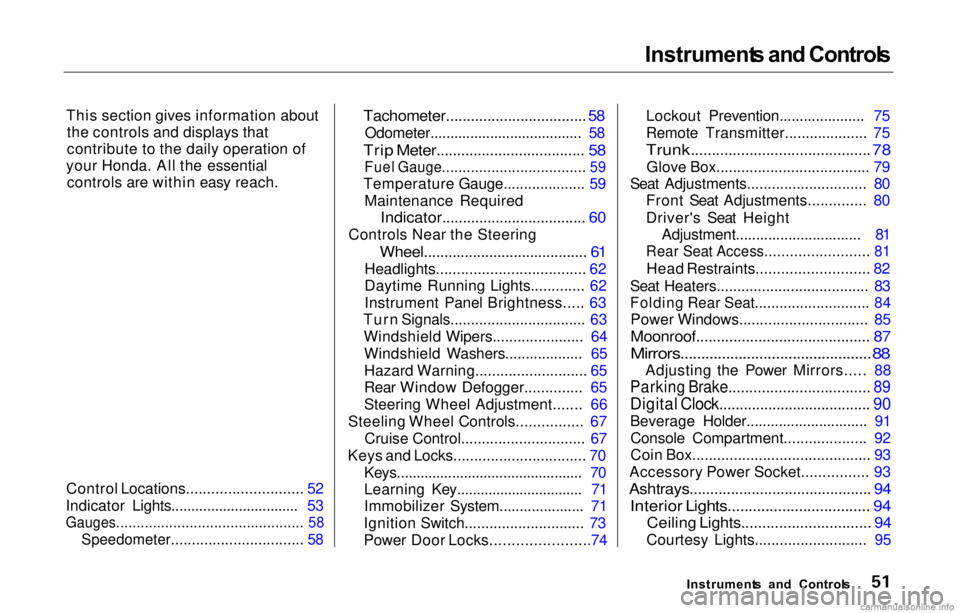
Instrument
s an d Control s
This section gives information about the controls and displays that
contribute to the daily operation of
your Honda. All the essential controls are within easy reach.
Control Locations............................ 52
Indicator Lights................................ 53
Gauges.............................................. 58
Speedometer................................ 58
Tachometer..................................
58
Odometer...................................... 58
Trip Meter.................................... 58
Fuel Gauge...................................
59
Temperature Gauge.................... 59
Maintenance Required
Indicator...................................
60
Controls Near the Steering
Wheel........................................
61
Headlights....................................
62
Daytime Running Lights............. 62
Instrument Panel Brightness..... 63
Turn Signals................................. 63
Windshield Wipers...................... 64
Windshield Washers................... 65
Hazard Warning........................... 65
Rear Window Defogger.............. 65
Steering Wheel Adjustment....... 66
Steeling Wheel Controls................ 67
Cruise Control.............................. 67
Keys and Locks................................ 70
Keys............................................... 70
Learning Key................................ 71
Immobilizer System..................... 71
Ignition Switch............................. 73
Power Door Locks.......................74
Lockout Prevention..................... 75
Remote Transmitter ...................
. 75
Trunk...........................................
78
Glove Box..................................... 79
Seat Adjustments............................ .
80
Front Seat Adjustments.............. 80
Driver's Seat Height Adjustment............................... 81
Rear Seat Access......................... 81
Head Restraints........................... 82
Seat Heaters..................................... 83
Folding Rear Seat............................ 84
Power Windows............................... 85
Moonroof.......................................... 87
Mirrors..............................................
88
Adjusting the Power Mirrors..... 8
8
Parking Brake.................................. 89
Digital Clock..................................... 90
Beverage Holder..............................
91
Console Compartment.................... 92
Coin Box.......................................... .
93
Accessory Power Socket................ 93
Ashtrays............................................ 94
Interior Lights.................................. 94
Ceiling Lights............................... 94
Courtesy Lights........................... 95
Instrument s an d Control s
Page 86 of 293
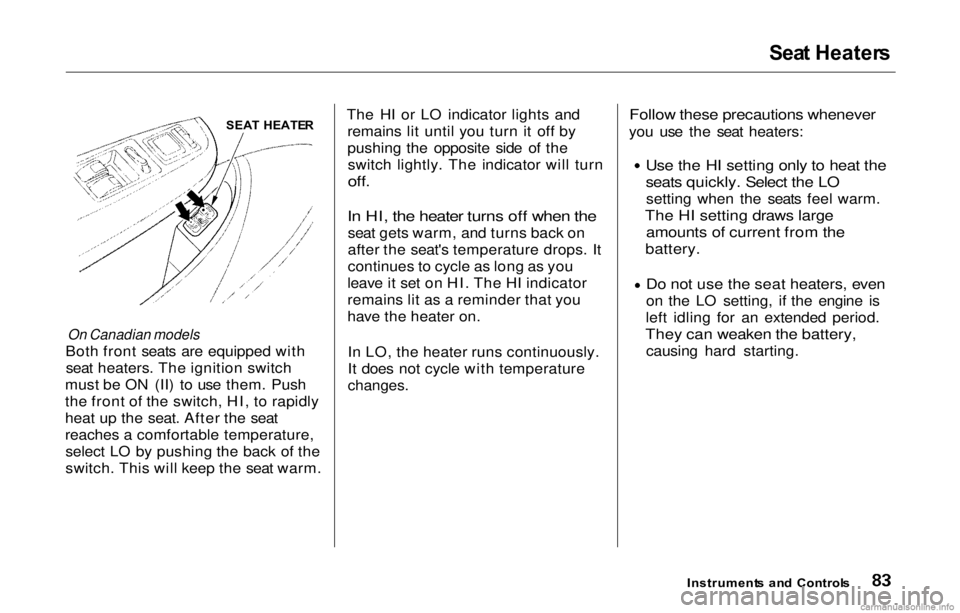
Sea
t Heater s
On Canadian models
Both front seats are equipped with seat heaters. The ignition switch
must be ON (II) to use them. Push
the front of the switch, HI, to rapidly
heat up the seat. After the seat
reaches a comfortable temperature, select LO by pushing the back of the
switch. This will keep the seat warm. The HI or LO indicator lights and
remains lit until you turn it off by
pushing the opposite side of theswitch lightly. The indicator will turn
off.
In HI, the heater turns off when the
seat gets warm, and turns back on
after the seat's temperature drops. It
continues to cycle as long as you
leave it set on HI. The HI indicator
remains lit as a reminder that you
have the heater on.
In LO, the heater runs continuously.
It does not cycle with temperature
changes.
Follow these precautions whenever
you use the seat heaters:
Use the HI setting only to heat the
seats quickly. Select the LO
setting when the seats feel warm.
The HI setting draws large amounts of current from the
battery.
Do not use the seat heaters, even
on the
LO setting, i
f the engine is
left idling for an extended period.
They can weaken the battery,
causing hard starting.
Instrument s an d Control s
SEA
T HEATE R
Page 92 of 293
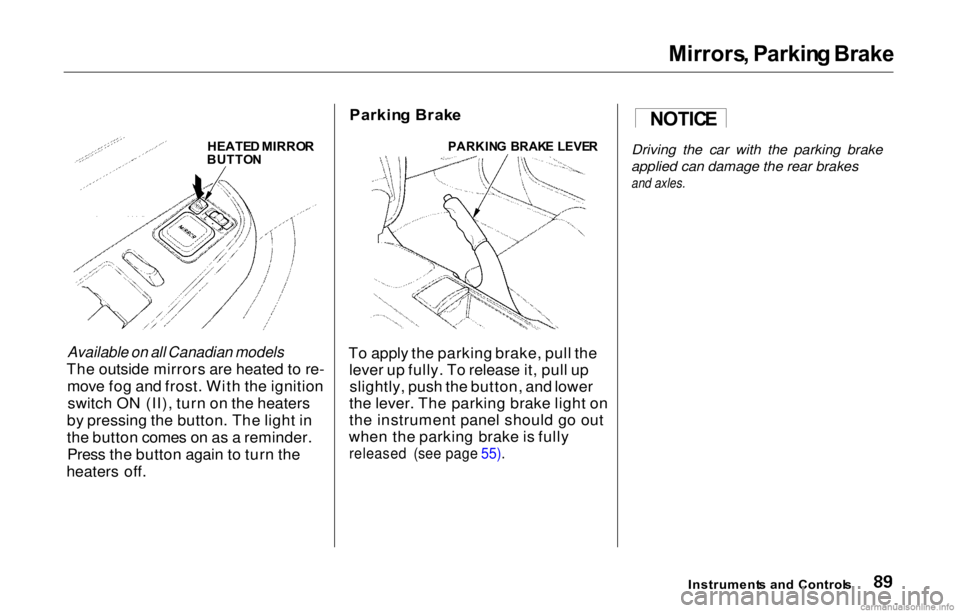
Mirrors
, Parkin g Brake
Available on all Canadian models
The outside mirrors are heated to re- move fog and frost. With the ignitionswitch ON (II), turn on the heaters
by pressing the button. The light in
the button comes on as a reminder. Press the button again to turn the
heaters off. Parkin
g Brak e
To apply the parking brake, pull the lever up fully. To release it, pull upslightly, push the button, and lower
the lever. The parking brake light on
the instrument panel should go out
when the parking brake is fully
released (see page 55).
Instruments an d Control s
Driving the car with the parking brake
applied can damage the rear brakes
and axles.
HEATE
D MIRRO R
BUTTO N
PARKIN
G BRAK E LEVE R NOTIC
E
Page 103 of 293
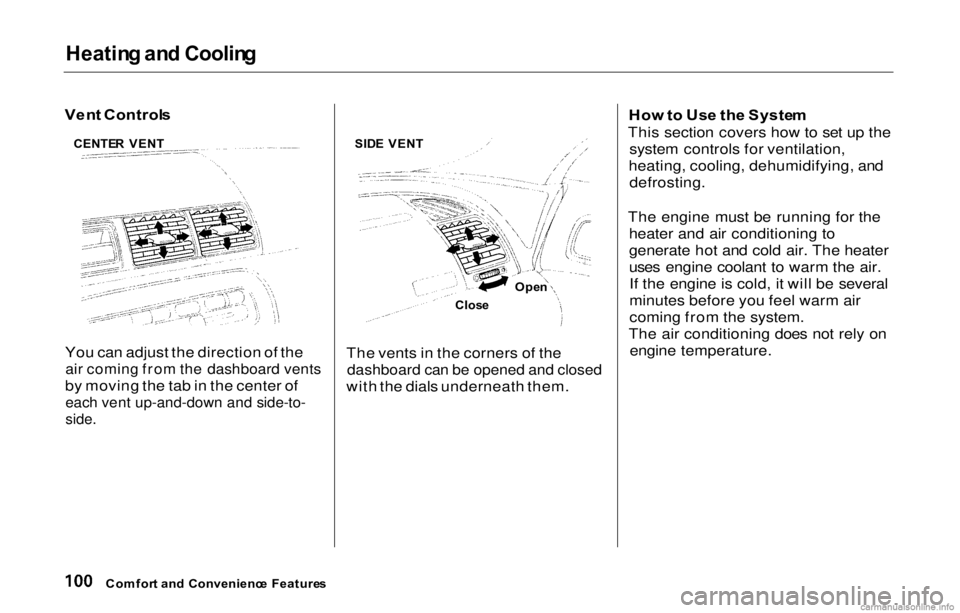
Heatin
g an d Coolin g
Ven t Control s
You can adjust the direction of the
air coming from the dashboard vents
by moving the tab in the center of
each vent up-and-down and side-to-
side.
The vents in the corners of the
dashboard can be opened and closed
with the dials underneath them. Ho
w to Us e th e Syste m
This section covers how to set up the system controls for ventilation,
heating, cooling, dehumidifying, and defrosting.
The engine must be running for the heater and air conditioning to
generate hot and cold air. The heater
uses engine coolant to warm the air.If the engine is cold, it will be several
minutes before you feel warm air
coming from the system.
The air conditioning does not rely on engine temperature.
Comfor t an d Convenienc e Feature s
CENTE
R VEN T
Open
SID
E VEN T
Close
Page 106 of 293
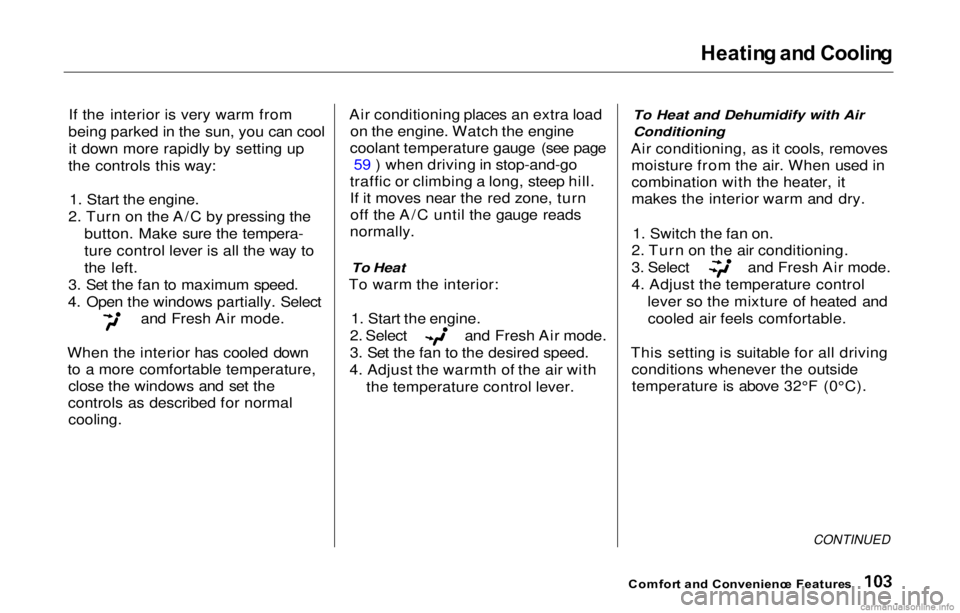
Heatin
g an d Coolin g
If the interior is very warm from
being parked in the sun, you can cool it down more rapidly by setting up
the controls this way:
1. Start the engine.
2. Turn on the A/C by pressing the button. Make sure the tempera-
ture control lever is all the way to
the left.
3. Set the fan to maximum speed.
4. Open the windows partially. Select and Fresh Air mode.
When the interior has cooled down to a more comfortable temperature, close the windows and set the
controls as described for normal
cooling.
Air conditioning places an extra load
on the engine. Watch the engine
coolant temperature gauge (see page 59 ) when driving in stop-and-go
traffic or climbing a long, steep hill.
If it moves near the red zone, turn off the A/C until the gauge reads
normally.
To Heat
To warm the interior:
1. Start the engine. 2. Select and Fresh Air mode.
3. Set the fan to the desired speed.
4. Adjust the warmth of the air with the temperature control lever.
To Heat and Dehumidify with Air
Conditioning
Air conditioning, as it cools, removes moisture from the air. When used in
combination with the heater, it
makes the interior warm and dry.
1. Switch the fan on.
2. Turn on the air conditioning. 3. Select and Fresh Air mode.
4. Adjust the temperature control
lever so the mixture of heated andcooled air feels comfortable.
This setting is suitable for all driving conditions whenever the outsidetemperature is above 32°F (0°C).
CONTINUED
Comfor t an d Convenienc e Feature s
Page 108 of 293

Heatin
g an d Coolin g
To remove exterior frost or ice from the windshield and side windowsafter the car has been sitting out in
cold weather:
1. Start the engine. 2. Select
When you select the
system automatically switches to
Fresh Air mode and turns on the
A/C.
3. Switch the fan and temperature controls to maximum.
To rapidly remove exterior frost or ice from the windshield (on very cold
days), first select the Recirculation
mode. Once the windshield is clear, select the Fresh Air mode to avoid
fogging the windows. These settings direct all the air flow
to the defroster vents at the base of
the windshield and the side window defroster vents. The air flow will get
warmer and clear the windows faster as the engine warms up. You can
close the side vents with the dial
underneath each vent. This will send
more warm air to the windshield
defroster vents.
For safety, make sure you have a
clear view through all the windows
before driving away.
T
o Tur n Everythin g Off
To shut off the system temporarily, slide
the fan speed an
d temperature
control levers all the way to the left.
You should shut the system completely off only for the first few
minutes of driving in cold weather,
until the engine coolant warms upenough to operate the heater. Keep
the fan on at all other times so stale air does not build up in the interior.
Comfor t an d Convenienc e Feature s
Page 190 of 293
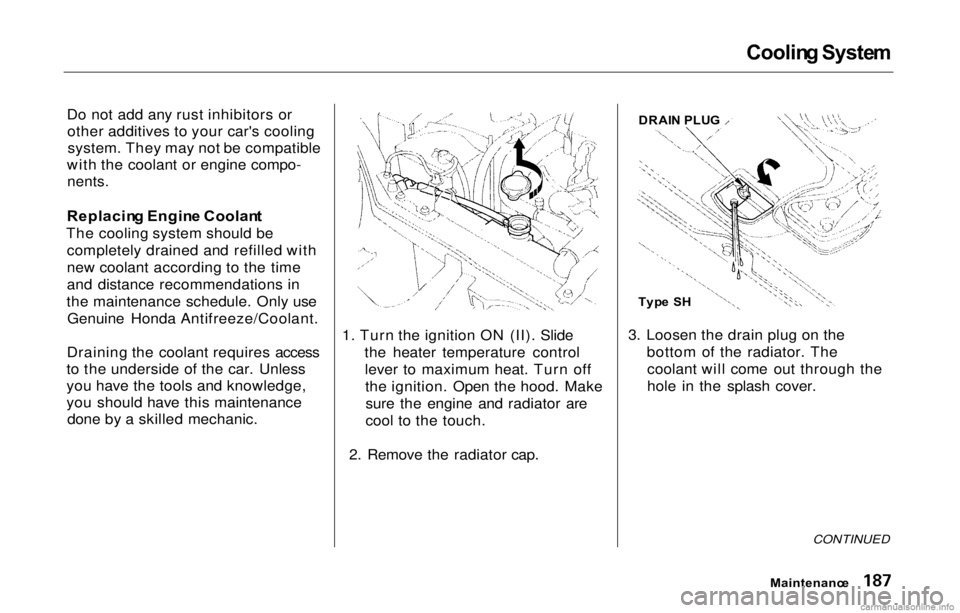
Coolin
g Syste m
Do not add any rust inhibitors or other additives to your car's coolingsystem. They may not be compatible
with the coolant or engine compo-
nents.
Replacin g Engin e Coolan t
The cooling system should be completely drained and refilled with
new coolant according to the time
and distance recommendations in
the maintenance schedule. Only use Genuine Honda Antifreeze/Coolant.
Draining the coolant requires access
to the underside of the car. Unless
you have the tools and knowledge,
you should have this maintenance done by a skilled mechanic. 1. Turn the ignition ON (II). Slide
the heater temperature controllever to maximum heat. Turn offthe ignition. Open the hood. Makesure the engine and radiator are
cool to the touch.
2. Remove the radiator cap. 3. Loosen the drain plug on the
bottom of the radiator. Thecoolant will come out through the
hole in the splash cover.
CONTINUED
Maintenanc e
DRAI
N PLU G
Typ e S H
Page 247 of 293

If You r Engin e Won' t Start , Jum p Startin g
The Starte r Operate s Normall y
In this case, the starter motor's speed sounds normal, or even faster
than normal, when yon turn the
ignition switch to START (III), but
the engine does not run.
Are you using the proper starting procedure? Refer to Startin g th e
Engin e on page 141.
Do you have fuel? Turn the
ignition switch to ON (II) for a
minute and watch the fuel gauge.
The low fuel level warning light may not be working, so you werenot reminded to fill the tank.
There may be an electrical problem, such as no power to the
fuel pump. Check all the fuses
(see page 254).
If you find nothing wrong, you will
need a qualified technician to find
the problem. See Emergenc y
Towin g on page 258 . Jum
p Startin g
If your car's battery has run down,
you may be able to start the engine by using a booster battery. Although
this seems like a simple procedure,
you should take several precautions.
You cannot start a Honda with an automatic transmission by pushing
or pulling it. To jump start your car, follow these
directions closely:
1. Open the hood and check the physical condition of the battery(see page 198). In very cold
weather, check the condition of the electrolyte. If it seems slushyor like ice, do not try jump starting
until it thaws.
If a battery sits in extreme cold, the
electrolyte inside can freeze.
Attempting to jump start with a frozen
battery can cause it to rupture.
2. Turn off all the electrical acces-
sories: heater, A/C, stereo system,
lights, etc.
Put the transmission in Neutral or
Park and set the parking brake.
Takin g Car e o f th e Unexpecte d
A battery can explode if you do
not follow the correct procedure,
seriously injuring anyone nearby.
Keep all sparks, open flames,
and smoking materials away
from the battery.
NOTIC E
Page 252 of 293
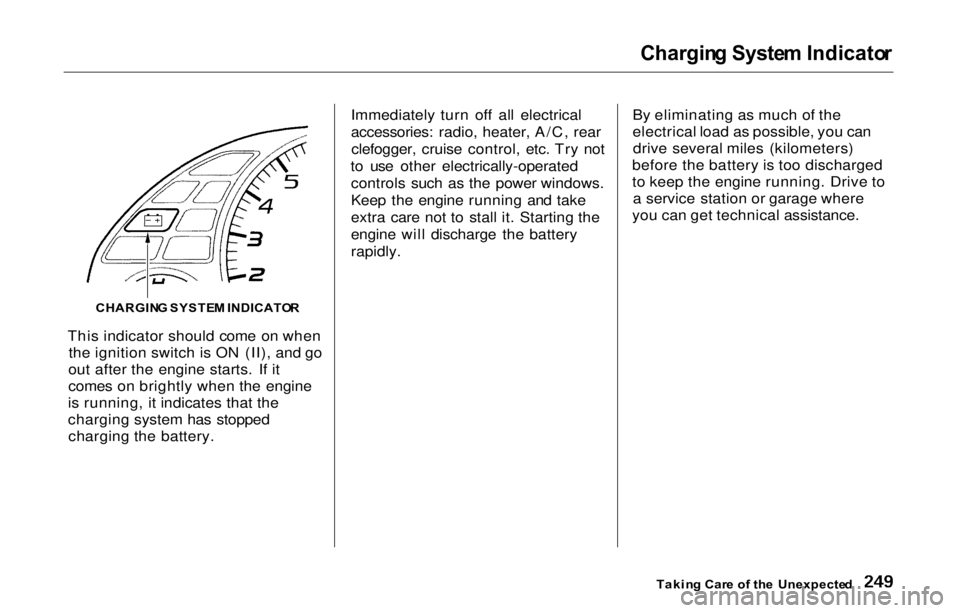
Chargin
g Syste m Indicato r
This indicator should come on when the ignition switch is ON (II), and go
out after the engine starts. If it
comes on brightly when the engine
is running, it indicates that the
charging system has stopped charging the battery. Immediately turn off all electrical
accessories: radio, heater, A/C, rear
clefogger, cruise control, etc. Try not
to use other electrically-operated controls such as the power windows.
Keep the engine running and take
extra care not to stall it. Starting the
engine will discharge the battery
rapidly. By eliminating as much of the
electrical load as possible, you can
drive several miles (kilometers)
before the battery is too discharged
to keep the engine running. Drive to a service station or garage where
you can get technical assistance.
Takin g Car e o f th e Unexpecte d
CHARGIN
G SYSTE M INDICATO R
Page 290 of 293
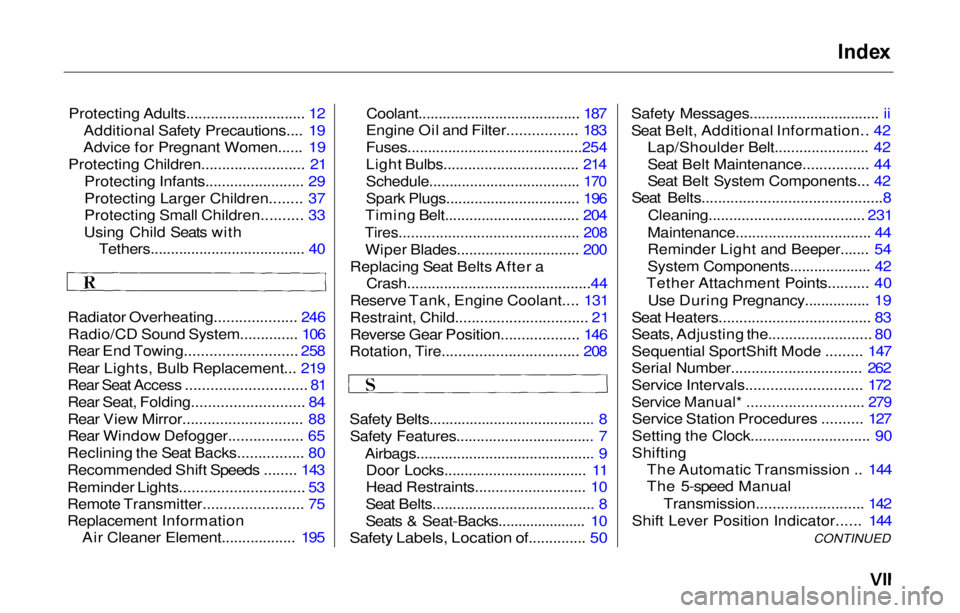
Inde
x
Protecting Adults............................. 12 Additional Safety Precautions.... 19
Advice for Pregnant Women...... 19
Protecting Children......................... 21 Protecting Infants........................ 29
Protecting Larger Children........ 37
Protecting Small Children.......... 33
Using Child Seats with Tethers...................................... 40
Radiator Overheating.................... 246 Radio/CD Sound System.............. 106
Rear End Towing........................... 258
Rear Lights, Bulb Replacement... 219
Rear Seat Access ............................. 81
Rear Seat, Folding........................... 84
Rear View Mirror............................. 88
Rear Window Defogger.................. 65
Reclining the Seat Backs................ 80
Recommended Shift Speeds ........ 143
Reminder Lights.............................. 53
Remote Transmitter........................ 75
Replacement Information Air Cleaner Element.................. 195
Coolant........................................ 187
Engine Oil and Filter................. 183
Fuses...........................................254
Light Bulbs................................. 214
Schedule..................................... 170
Spark Plugs................................. 196
Timing Belt................................. 204
Tires............................................ 208
Wiper Blades.............................. 200
Replacing Seat Belts After a
Crash.............................................44
Reserve Tank, Engine Coolant.... 131
Restraint, Child................................ 21
Reverse Gear Position................... 146
Rotation, Tire................................. 208
Safety Belts......................................... 8
Safety Features.................................. 7
Airbags............................................ 9Door Locks................................... 1
1
Head Restraints........................... 10
Seat Belts........................................
8
Seats & Seat-Backs...................... 10
Safety Labels, Location of.............. 50
Safety Messages................................
ii
Seat Belt, Additional Information..
4
2
Lap/Shoulder Belt....................... 42
Seat Belt Maintenance................ 44
Seat Belt System Components... 42
Seat Belts............................................8
Cleaning...................................... 231
Maintenance................................. 44
Reminder Light and Beeper....... 54
System Components.................... 42
Tether Attachment Points.......... 40
Use During Pregnancy................ 19
Seat Heaters..................................... 83
Seats, Adjusting the......................... 80
Sequential SportShift Mode ......... 147
Serial Number................................ 262
Service Intervals............................ 172
Service Manual* ............................ 279
Service Station Procedures .......... 127
Setting the Clock............................. 90
Shifting The Automatic Transmission .. 144
The 5-speed Manual
Transmission.......................... 142
Shift Lever Position Indicator...... 144
CONTINUED